How to Use HCA Scores to Weed Out Poorly Cut Diamonds
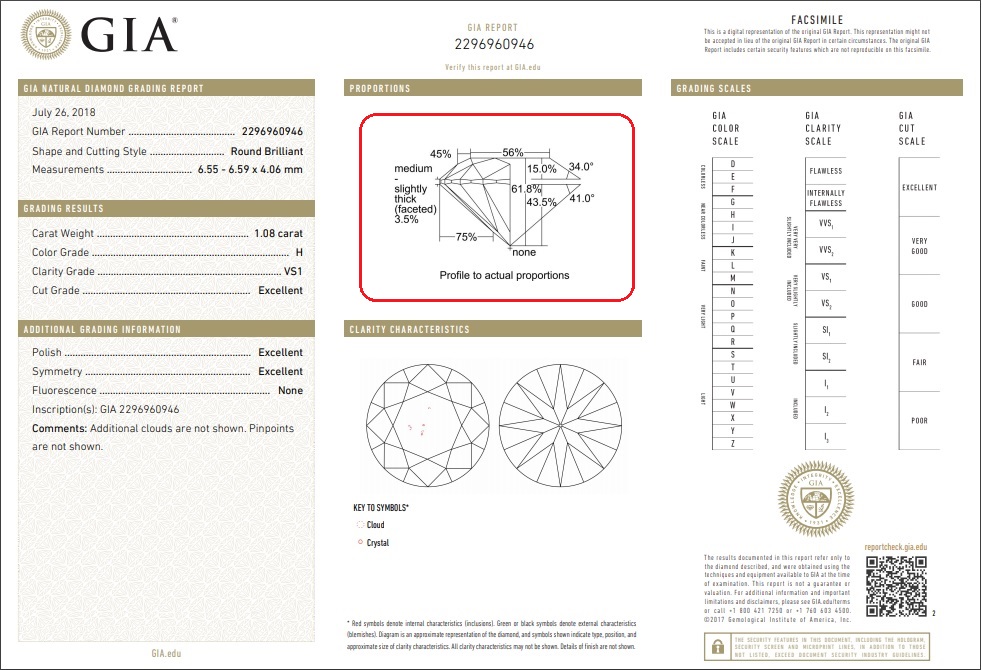
When it comes to reading a diamond grading report, the proportions diagram is probably the section that raises the most eyebrows. It depicts technical information like the table/depth percentages, crown/pavilion angles and upper/lower girdle facet length of the diamond.
However, most of us cannot do anything meaningful with these data apart from comparing them against tables of “recommended proportions”. Fortunately, there is a simple system developed by Garry Holloway that can help you glean deeper into a round diamond’s proportions.
The Holloway Cut Advisor, or as it is most commonly known, the “HCA”, simplifies the process of judging the potential quality and light performance of a standard round brilliant cut.
Let us take a look at how it works and why it can be a handy tool especially if you intend to purchase an engagement ring “blind”.
A Brief History of the Holloway Cut Advisor
The founder of HCA, Garry Holloway, is not a newcomer in the industry and has been in the business since the early ’70s. One of his goals is to improve the overall cut quality of diamonds in the market and he is actively involved in cutting edge research work with scientists from Russia and India.
After spending a lot of time in studying round diamonds and understanding how various diamond proportions/angles affect light return, he developed the HCA software.
This program enables the layman to key in variables found in a grading report and provides an instant prediction on the diamond’s visual appeal and performance.
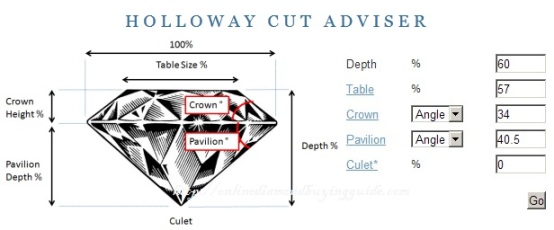
Upon entering data into the HCA software, it will return a score ranging from 0 to 10 (a numerical figure below 2.0 is desired).
2-4 Very Good
4-6 Good
6-8 Fair
8-10 Poor
An Overview of the Software’s Strengths
Basically, the HCA provides an assessment of a diamond’s potential light return, scintillation, spread and fire based on its cut proportions. It attempts to assess features that are closer to the actual visual appearance of a diamond and the grade is determined based on 4 factors:
Light Return
Fire
Scintillation
Spread
Combined, these 4 factors result in the Total Visual Performance of a diamond. An HCA score of less than 2 denotes a diamond that is predicted to have desirable qualities and one that reflects light in an optimal way.
Note: The Holloway Cut Advisor can never replace the tangible information that an ASET/Idealscope or video provides, but it can definitely be considered a useful tool that you can use on your own, for free.
Video: How to Use the Holloway Cut Advisor Tool
Using the HCA as a Quick & Easy Rejection Tool
Here’s an example of how you can use it to weed out seemingly similar looking stones based on grading certifications. For comparison’s sake, I chose 2 round diamonds from James Allen which are graded by GIA as Excellent cuts and plugged their cut proportions into the tool.
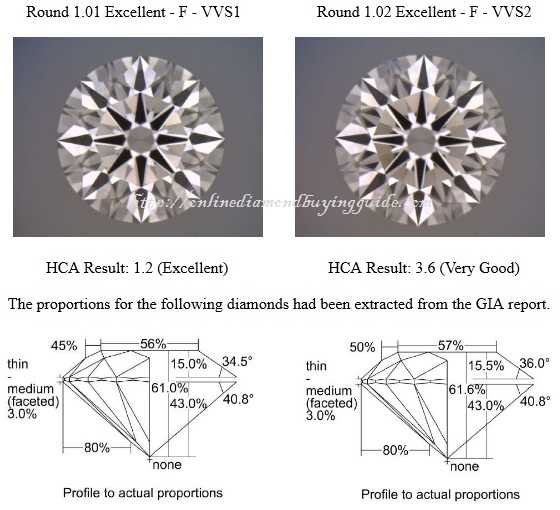
As you can see, the HCA tool is a very fast and handy tool to help you weed out stones that fall short of having great optics. From the results above, I would instantly reject the diamond on the right based on the HCA findings.
While the diamond on the left receives a 1.2 score, it simply means the diamond passes the initial filtering test. In order to confirm the light performance of the diamond, you need to rely on idealscope or ASET data to find out more details.
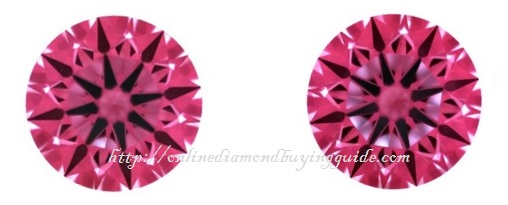
Corresponding idealscope images of the diamonds.
The diamond on the left shows a round brilliant diamond with strong light return under the Idealscope (although the light return can arguably be improved). On the right, the image blatantly shows a leaky stone with light loss through the table facet (indicated by the pale ring).
Even the Software Has Its Weaknesses – What You Need to Know
On first glance, the HCA tool might appear to be the smartest application ever created for the diamond shopper. However, a good score on the HCA tool doesn’t necessarily indicate a diamond with best light performance/precision due to a variety of reasons.
The first reason behind having discrepancies is that the HCA tool only utilizes the measurements of 17 out of a total of 57 facets for its analysis. Besides relying on averaged readings, the HCA tool fails to take into account the girdle thickness variations, polish and symmetry ratings.
Also, the HCA tool doesn’t take into account the star facets, upper and lower girdle facet proportions, This means that it cannot accurately reveal whether the scintillation pattern of the diamond takes on a pinfire or a broader flash characteristic.
Combined as a whole, every single facet of a diamond comes together to form a complex relationship which affects its visual appearance and light performance. In fact, I’ve written a comprehensive article about the pitfalls of the HCA tool here.
The next shortfall of the HCA is that it is only applicable for round brilliant cut diamonds. Fancy shapes or modified round cuts cannot be subjected to a similar analysis because the algorithm simply doesn’t work for them.
There are also other factors that can influence the visual appearance and the value of a diamond. For example, a diamond’s HCA score will not reflect potential problems caused by a low clarity grade. Issues that may cause the stone to take up a hazy appearance or have adverse impacts on brilliance cannot be realistically predicted by a computer algorithm.
Conclusion: Usage And Results of the HCA
Taking everything into account, we can say that the HCA score is only useful to a certain degree. However, you need to bear in mind that the tool only provides quick results based on a limited set of data inputs.
Very often, people take the results of the HCA too literally and make the mistake of making a purchase decision without looking at tangible data. The Holloway Cut Advisor is not meant as a tool for selection but rather, a tool to reject poorly proportioned stones.
Once you have weeded out the poor performers which score more than 2.0 on the HCA, you should apply other optical examination tools like the ASET or Idealscope in your final selection process. This will help you cherry pick the most brilliant stone from the remaining diamonds with HCA scores of less than 2.0.
With the advanced computing technology available, the HCA’s usefulness has been severely diminished. Reliable jewelry retailers with transparent business practices are able to provide you with videos and scope data to help you see exactly what you are buying.
Listing at White Flash with video, photos and scope data for easy analysis.
Related Articles
Leave A Comment

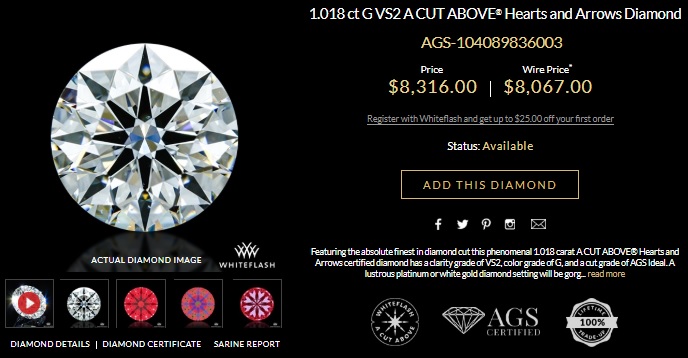
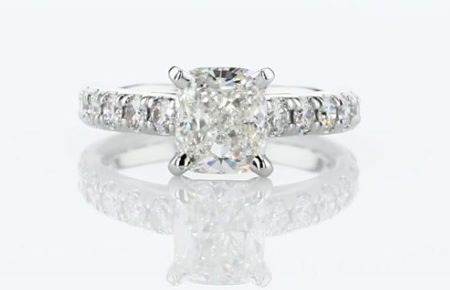
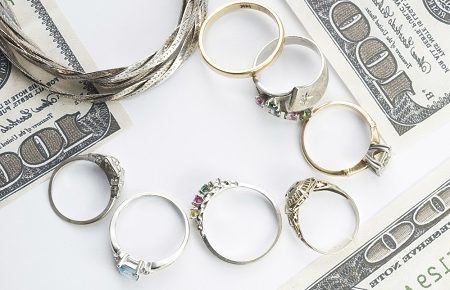
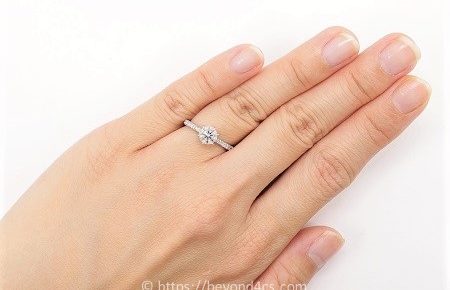
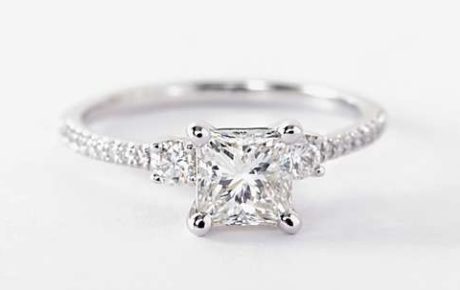









11 Comments
I don’t really get the part on scintillation about pinfire or broad flash scintillation. When I entered in values for pavilion and crown angles into the HCA software, it returns an Excellent rating for the scintillation and a 1.8 for Total Visual Performance.
Should I try to get a diamond that has less than 1.0 in score so that it performs better?
Hi Jocelyn,
A low score of 0.6 or 0.4 on the HCA doesn’t necessarily mean it will look better in real life as compared to another with 1.8. You should look at its this way. A diamond with less than 2.0 on the HCA passes the first round of quality checks.
Take note, 2 diamonds with the same exact set of proportions will have the same HCA score. However, these 2 diamond may look completely different in reality. Thereafter, you need to get more data on the particular stone you are interested in.
With regards to the broad flash or pinfire characteristics, this is largely depended on the lower girdle facet length. Typically, a length of more than 85% will result in a splintery look while ranges between 75% to 80% tend to display chunkier flashes of light.
Hope this helps!
Paul
Hi Paul,
Can I conclude that any diamond with more than HCA 2.0 is not worth to considering?
To be on the safe side of choosing a well-cut diamond, I would say yes.
However, if you have idealscope/ASET images and they indicate a nicely cut diamond, then the HCA score doesn’t really matter. There do exist well-cut diamonds with HCA scores between 2.0 – 3.0.
If that’s the case, have you seen any diamond that have HCA 4-5 but very good cut under the scope?
No. None that I can recall.
First of all, please allow me to thank you for your excellent blog – I found it extremely informative and helpful in my search for a diamond.
I have narrowed down my search to this one diamond on James Allen and I would be very grateful if you could give me your honest opinion on it.
The link to the ring is here: https://www.jamesallen.com/loose-diamonds/round-cut/0.80-carat-e-color-vs1-clarity-excellent-cut-sku-3762405 is a well cut diamond.
The HCA score for this diamond is 1.6.
I had to specially request for the Idealscope image as James Allen didn’t immediately have it on hand (due to the fact that the diamond is from one of their partner’s inventory, apparently). I have attached the Idealscope image with this email.
The price of the diamond is USD4,770 (setting is an additional USD830).
Some questions I have:
1. What is your frank opinion of the diamond, especially with regards to the light performance? There seems to be quite a bit of light leakage on the table facet (or am I reading it wrong)?
2. The arrows seem to be a bit “fat” – does this matter?
3. Anything else I should be aware of?
Many thanks in advance!
https://www.jamesallen.com/loose-diamonds/round-cut/0.80-carat-e-color-vs1-clarity-excellent-cut-sku-3762405 is a well cut diamond.
And just to be clear, what you are seeing in the idealscope image is NOT light leakage. Light leakage is entirely white in color. The diamond has some slight inconsistencies in performance and lesser brightness under the table. Overall, still a well cut diamond.
The fat arrows are due to the lower girdle facets of 75%. It’s a non issue as well and it makes the diamond take on a scintillation pattern with bigger and broader fire dispersion.
So no worries there.
Hi Paul,
just for your information:
Your link to the HCA software on Gary Holloway’s website http://www.idealscope.com has been deleted for some months. He shifted it to https://www.pricescope.com/tools/hca. For private users it is free of charge. Professional users pay for it now.
Cheers, Torsten
Firstly, a sincere thank you for all the effort you have put into the Beyond4c’s website. I have spent many hours reading and studying the content you have written. It has been the only source I have found which has provided easy to follow, yet detailed advice on choosing a diamond engagement ring. Like you, I come from a science/research background so I really appreciate the research that has gone into providing such detailed information – without just pages of vague terms (‘brilliance’, ‘exacting standards’, ‘rarest diamonds’ and other marketing fluff) like many other websites.
While your website has been hugely helpful, it has also left me with a bit of a headache. I had been told that buying a GIA Triple Excellent diamond would ensure that, if purchasing blind, would ensure an amazing diamond. Of course, I now know this is definitely not the case.
My issue is this – I have looked through all your recommended vendors (WhiteFlash, BG, James Allen etc) and the ring that I like by far the most is from Brilliant Earth. As you know, Brilliant Earth does not offer ASET/Idealscope/H&A images for its diamonds – nor does it allow the purchase of a setting without an accompanying diamond. I have been in contact with their customer assistance and gemological team and haven’t really had much luck in that regards. I tried to narrow down a list of diamonds using your recommendations (ideal proportions, ‘super ideal’ cute, excellent symmetry and polish) and HCA scores as a rejection tool. I sent through a list of approximately 8-10 diamonds a couple weeks ago – of these, I was able to get an ASET image for one (showed very poor light return) and Sarin and H&A images for two – both had only very good symmetry on Sarin reports, despite being ‘GIA Triple Ex’ diamonds.
So I am emailing you hoping to get some advice regarding my next steps. Do you think that a 360 degree HD video (in conjunction with grading reports and HCA scores) are sufficient information to purchase a diamond online? Or should I keep waiting on Brilliant Earth to have some diamonds with ASET/Idealscope/H&A images to become available? (The issue with that is my planned proposal date is approaching and I would like to finalize an engagement ring sooner rather than later).
I have been spent the last few weeks looking at HD 360 degree diamond videos, but do not feel confident in my skills and knowledge to choose a diamond based on this. I have found these videos seem to have come from several different locations (based on lighting, background etc) which makes it hard (in my limited experience) to compare. For example, this (https://www.brilliantearth.com/rings/cyorings/view_diamond/4805165/) diamond seems to have better optical performance in the video (despite a HCA score of 3.7 and high crown angle and depth) compared to this diamond https://www.brilliantearth.com/rings/cyorings/view_diamond/4899361/ (HCA 1.9, better proportions). The first diamond video seems to have been taken in a more well-lit environment and from a slightly increased distance on a whiter background.
The requirements I have been basing my search on are as below:
Budget: $3500-$4500 AUD (diamond only). There is some lee-way here if required to get an ideal diamond.
Shape: round brilliant
Cut: super ideal (using brilliant earth’s nomenclature)
Carat: 0.7-0.9 ct
Colour: J or above
Clarity: eyeclean
If you could provide any advice or recommendations it would be most, most appreciated!
Coincidentally, the ring(s) in question are the Hudson or Luxe Hudson rings (in 18k White Gold) that you reviewed in your ‘Vintage’ ring purchase article – I haven’t quite decided on which. Do you believe that the melee diamonds in the Luxe Hudson ring would provide much visual benefit over the ‘standard’ Hudson ring? Also, would the 4 prong (of the Luxe Hudson) benefit a diamond of the above specifications over the 6-prong standard Hudson?
Thank you again for your amazing website and assistance! Although, in a way, you have made this purchase much harder, I am so thankful that I can make a purchase knowing that my intended fiancee will have a stunning ring!
I looked at both diamonds and this is the better cut diamond. For a brilliant earth diamond, this is a good find.
I can tell you that this stone will have a relatively strong idealscope image. From experience, it is possible to decipher performance based on the videos.
As for the choice of setting, it really depends on your personal preference. If you want to show the diamond off better, this would be the better setting. I need to reemphasize that the choice of setting is up to subjective preferences.
Go for the diamond above. It’s a good option.